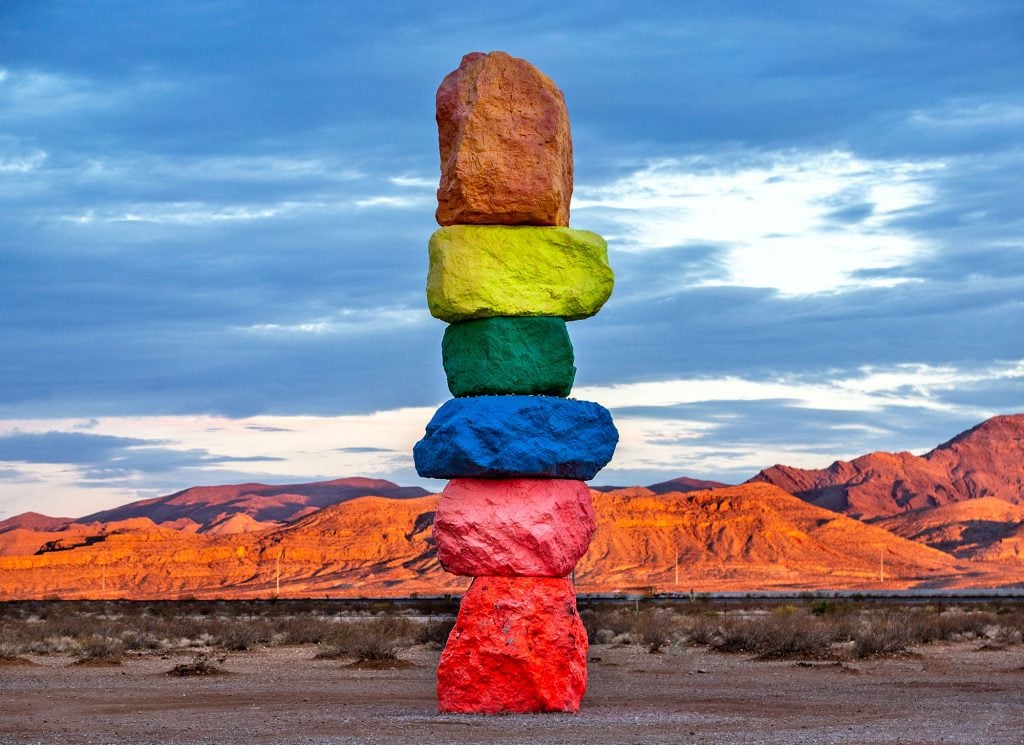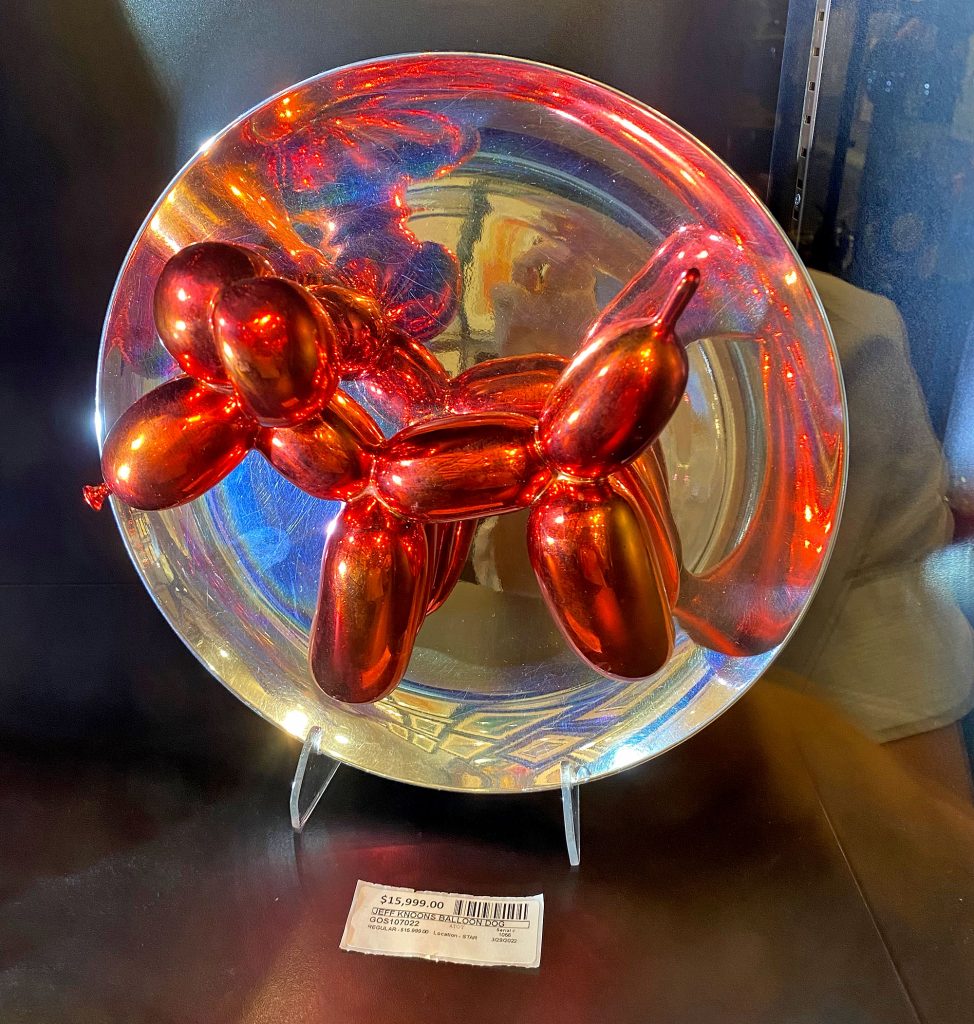Travel
In Las Vegas, You’ll Find Top-Notch Art in Casinos, Bars, Malls, Even the Desert—Everywhere Except Museums
Our writer offers a first-hand account of art hopping in the desert city.

Our writer offers a first-hand account of art hopping in the desert city.

Janelle Zara

I have a profound and deeply improbable love for Las Vegas, a place I’d never expect to like at all. But improbability is the lifeblood of this town, according to Dave Hickey, late art critic and longtime resident. In his 1997 essay, “At Home in the Neon,” he described the true heart of the city as the sublime and irrational thrill of going against the odds. Las Vegas lives, he wrote, “in those fluttery moments of faint but rising hope, in the possibility of wonder, in the swell of desire while the dice are still bouncing, just before the card flips face-up.” In short, he continued, “anything can happen.”
There is, in Las Vegas, a singular commitment to simply having a good time. The highest of high-brow comfortably coincides with the cheapest of thrills; although the architecture is fake, the enthusiasm is real. Art is commodified and reduced to spectacle, but also ubiquitous, accessible, and often top quality. With no major institution in town, you tend to find works in unexpected places: embedded into the surrounding landscape, from Michael Heizer’s City (1970–2022) and Double Negative (1969) to Ugo Rondinone’s Seven Magic Mountains (2017), or installed in shopping malls and hotel bars. Then there is digital artist Refik Anadol’s exterior LED screen of the soon-to-debut Sphere events venue, billed as the largest such screen in the world.
“Our museums are actually our casinos,” said Neon Museum Las Vegas director Aaron Berger, a true Vegas insider. He recommends visiting Jeff Koons’s mirror-polished Tulips sculpture at The Wynn with “a cigarette in one hand and a martini in another.” I recommend a visit to the Neon Museum for a surprise lesson in urban history.
The following introductory guide is full of real recommendations and personal favorites. Hickey lovingly wrote that Las Vegas is “an ardent explosion of lights in the heart of the pitch-black desert,” and my hope is that you’ll love it, too.

At the MGM-owned Vdara, Frank Stella’s Damascus Gate Variation I (1969) sets the tone of the hotel: minimalist, elegant and expensive.
On and off the strip, as Berger mentioned, art abounds in Las Vegas casinos, and the collection will tell you a lot about your stay. Take the Michelangelo replicas and kitsch Mona Lisa wallpapers at Caesars Palace, for example. They emphasize approachability, where the opulence is only make-believe.
Conversely, the Palms Casino Resort’s $100,000-a-night, Damien Hirst-designed Empathy Suite appeals to a specific high-stakes and perhaps hubristic gambler. Collector brothers Frank and Lorenzo Fertitta unveiled the suite in 2019, only to sell the hotel two years later at a loss. If your luxury ideal is glossy surfaces and brand recognition, try the Wynn. The Koons tulips are in the same line of sight as a spinning neon Takashi Murakami/Virgil Abloh sculpture and boutiques for Hermès and Saint Laurent.
The Bellagio is a great choice for first-time visitors in that it’s central and quintessentially Las Vegas. When then-owner Steve Wynn opened the hotel in 1998, his pioneering inclusion of real art set a new standard of Vegas luxury. The vibe maintains its late-’90s sophistication with villa-inspired architecture, the Bellagio Gallery of Fine Art, commissioned Rauschenbergs decking the halls, and fine dining restaurants hung with Sol Lewitts and Lichtensteins. (The Picasso restaurant once featured real Picasso paintings, but they were recently sold by current operator MGM. “It used to feel like dining in a museum,” one longtime server lamented.)
The Aria offers the same blue-chip sensibility but in a decidedly more contemporary form, with Rashid Johnson paintings and sculptures by Sanford Biggers and Maya Lin. The curtain of LED lights in the parking bay is Jenny Holzer’s VEGAS (2009), scrolling with 200 of her truisms, one of which might be an excellent mantra for your trip: “Thinking too much can only cause problems.”

Damien Hirst, The Unknown (Explored, Explained, Exploded) (1999), at Unknown bar. Courtesy of the Palms Hotel and Casino.
Vegas is an incredible food city—full stop. Its Thai is arguably better than anywhere in the United States—try the upscale Lotus of Siam or the hip Le Thai—and every super-hyped, oversubscribed coastal restaurant is shockingly accessible. You do need a reservation to eat xiaolongbao at Din Tai Fung, where photographic collages by Parker Ito hang in the entrance, but I kid you not, I have shown up at Carbone and just strolled right in. Still on my list is the carnivalesque Superfrico, which bills its cuisine as “Italian American psychedelic.” I’m intrigued to find out what that means.
Throughout the city, every bar is potentially your new favorite bar, because generally everyone’s on their friendliest, most open behavior. Between the adrenaline rush of the casino and the 24-hour availability of alcohol, this town has a way of eroding your inhibitions and expanding your comfort zone. At least once, you have to have a cocktail in the shadow of Damien Hirst’s 13-foot-long embalmed tiger shark at Unknown bar. I’m also a big fan of the Ski Lodge, a cozy and eccentric chalet-themed speakeasy hidden in the Cosmopolitan.
Away from the strip, I love the divey Sand Dollar Lounge and its excellent nightly live music. (Personally, I recommend the Spring Mountain Road location over the one downtown.) But not every drink needs a side of spectacle. My all-time favorite memory is the afternoon I spent at the bar of a Caesars Palace steakhouse day-drinking with an older Nevada couple I’ll likely never see again.

Buying and selling blue-chip art is easy. I once found a Koons mini Balloon Dog at the Gold & Silver Pawn Shop, priced at a rather inflated $15,999. Photo: Janelle Zara.
There is no recognizable art world in Las Vegas, but there is plenty of money and a huge appetite for spectacle. Naturally, art abounds like any other luxury good or form of entertainment. There are three separate James Turrell installations at Crystals shopping mall (in addition to one Immersive Van Gogh experience), and casino galleries—like museum gift shops—carry crowd-pleasing works like Picasso prints and Chagall works on paper.
The Perrotin Store, located at the Bellagio until at least January 2024, fully embodies the Vegas ethos of accessibility. The selection is top notch and the prices are relatively modest. It’s got prints and monographs and Paola Pivi’s delightfully bug-like 2014 Selima Optique sunglasses ($450), plus the score to Claire Tabouret’s 2019 HAB Galerie exhibition immortalized in vinyl ($550). Murakami merch—plush dolls, stationery, canvas tote bags cut from actual Murakami canvases ($10,000)—is far and away the store’s bestseller. Said the salesman at the register, “People go frickin’ crazy.”
For the most luxurious experience you can have in a shopping mall, simply call the Crystals Louis Vuitton and reserve a private viewing of Turrell’s Akhob (2013). A sales associate will whisk you to the shop’s secret third floor, where, for 25 minutes, you stand in a pair of womb-like chambers looking out into a seemingly infinite void. Turrell’s colored light simply registers as color—some pure, ambient material with no direction, no heat and no mass. The rising intensity is almost imperceptible, until suddenly it strikes you like a tsunami, and you’re briefly convinced that nothing else exists and you are nowhere. After your total obliteration, you’re sent back down to the boutique, but remember: no purchase necessary.